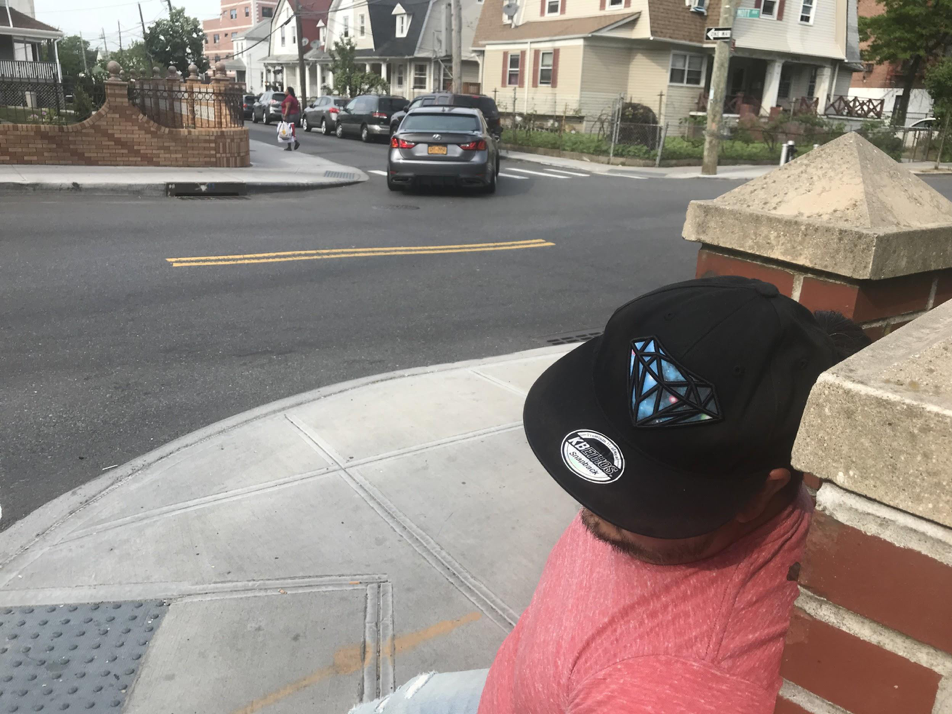This article was co-published with The Daily Beast.
It was early in the morning when Miguel found his Brooklyn apartment surrounded by people clad in vests emblazoned: “POLICE.”
He had refused to open the door when they first knocked. One of the men had called his cellphone to say, in Spanish, that they had been sent by his probation officer. The voice on the other end of the line was calm, beckoning him out.
“We’re police from probations,” the man said, according to Miguel*. “We have some papers here that you need to come out and sign, and then you can go back in no problem, we’ll leave. We only want to verify that you live here.”
It didn’t add up. Miguel had seen his probation officer the day before, and she hadn’t mentioned anything about paperwork or sending anyone over.
He furrowed his brow as he recalled the incident on a recent Saturday afternoon, standing on the cracked pavement outside his building. He told the man over the phone, “I was there yesterday, and she never told me that anyone was going to come,” Miguel recalled. The man then insisted that, given Miguel’s English proficiency, he must have misunderstood what his probation officer had told him.
He didn’t open the door, and after he hung up the phone, he watched from the window as most of the men packed into a couple SUVs and sped off. The woman he rented his room from later told him she noticed something else written on their vests: “ICE.”
According to attorneys and advocates, field officers with Immigration and Customs Enforcement have for years been known to misrepresent themselves as members of local law enforcement agencies in an attempt detain immigrants, a practice known internally as “ruses.” As municipal and state officials scale back cooperation with ICE, often in response to the agency’s ever-more aggressive tactics under the Trump administration, agents have been regularly resorting to deceptions that go way beyond merely identifying as “police.”
The tactic helps ICE gain access. “ICE is a law enforcement agency and they’re bound by the same constitutional restrictions as any law enforcement agency,” said Ghita Schwarz, senior staff attorney at the Center for Constitutional Rights.
Nancy Morawetz, a professor of clinical law and an immigration expert at New York University School of Law, said that though existing case law allows federal law enforcement agents to use ruses, she doesn’t believe it’s clearly legal for a federal officer to masquerade as a local one. “What ICE is doing is saying ‘Oh, it’s all the same question. If law enforcement can use ruses, then any ruse is an option,’” she said. “There is a pretty strong argument, I think, that it is impersonating a police officer,” a felony charge in New York state.
Fourth Amendment protections mean that even if agents know where a target lives, they cannot enter without either a judicial warrant or the occupant’s consent. Posing as local law enforcement officials is one way to create that consent. “The use of ruses is a way to skirt the constitutional protections and get in the door,” said Genia Blaser, senior staff attorney at the Immigrant Defense Project, which tracks ICE arrests.
According to Blaser, most of the cases Immigrant Defense Project hears about follow similar patterns: the agents call their target at a personal number, show up at their door, or both, and claim to be local officers of some type investigating a crime, executing a warrant, or responding to an accident.
That’s how it went for Aida*, a refugee from Senegal. There was a loud knock on her door early in the morning; she opened it and came face-to-face with an unidentified officer. She says she quickly realized they were police – they had guns and badges – “but I didn’t know what kind of police they were,” she said recently from a couch in her Brooklyn walkup, as her young son watched television nearby.
The officer asked if she had a son who worked at a supermarket. When she said she didn’t, the man told her that her oldest son’s identity had been stolen and was being used at a supermarket, and he needed to speak to her son Omar, face to face. “When I looked at his face, he was acting a little funny, and I closed my door,” Aida said.
Within minutes, agents called Omar*, on his cellphone and told him the same thing. By the time he left for work, the agents had gone to his wife’s house, where his mother-in-law spoke with them. They told her they had a warrant for Omar’s arrest but refused to tell her what it was for when she asked. “They said he had done something really bad,” his mother-in-law said. “They were asking, does my daughter know what type of person he is, what kind of person she’s dating?”
Eventually, the agents convinced Omar to leave work and meet them in front of his mother’s apartment. He called Aida and reassured her that he only wanted to get to the bottom of his identity theft. “He doesn’t even think about immigration. He thinks he is going with the local police,” she said. Hours later, Omar finally got back in touch. He was at 26 Federal Plaza, where the ICE agents had taken him to be processed before sending him to a detention center in New Jersey.
Internal training materials the agency released through Freedom of Information Act requests refer to the use of ruses. A 2010 copy of the Fugitive Operations Handbook calls them “a tactic designed to control the time and location of a law enforcement encounter” that results in “improved safety for the officers and the public by reducing the opportunity for the target to flee.” Both this handbook and guidance memos it draws on stipulate that “a ruse involving the impersonation of a federal, state, local, or private-sector employee is contingent on permission from the proposed cover employer.” It’s unclear whether this is currently ICE policy, but it appears no permission has been sought in New York.
Candace Sandy, a spokesperson for the New York City Department of Probations, said in an email that “any impersonation of a New York City Probation Officer would be of critical concern to this agency. We are not aware of, and have received no reports of any such activity taking place.” Reached by phone, Dalvanie Powell, president of the United Probation Officers Association, said she hadn’t heard of ICE impersonating her officers. “It is certainly a concern of mine,” she said. “I don’t know why anyone would go that far, and it disturbs me.”
In response to questions, ICE spokesperson Emilio Dabul denied that the tactic is in use. “[Enforcement Removal Operations] Deportation Officers do not identify themselves as members of any other organization. Deportation Officers may use the universally recognized ‘POLICE’ when initially making contact with someone during a field operation,” he wrote in an email.
NYPD leaders, including Commissioner James O’Neill, have maintained that they will not cooperate with ICE in order to preserve the public’s ability to safely report crime. In February, legislative affairs director Oleg Chernyavsky told the City Council that “it’s important for victims of crimes, irrespective of their immigration status, to trust their police and to come forward and inform their police.”
Yet advocates say that, as immigrants feel the lines start to blur between who is local law enforcement and who is ICE, they’re less likely to cooperate with anyone. “People still respect the police and they still want to help, but when the word is getting around that [ICE agents] are misidentifying themselves, we have no choice but to teach people not to open the door for any reason,” said Ravi Ragbir, the executive director of the New Sanctuary Coalition of NYC. “If the NYPD wants to keep this space safe, they have to also work with us, and become involved in that process.”
Ultimately, Morawetz, the NYU law professor, believes it’s up to state and local governments and agencies to push back. “I think if local law enforcement protested to [the Department of Homeland Security], they would get results,” she said. Neither the New York City Police Department nor its largest union, the Patrolmen’s Benevolent Association, responded to repeated requests for comment.
“[ICE’s] scorch-earth raids on our immigrant neighbors undermine public safety, and the egregious examples of their unconstitutional conduct sow fear in our communities,” said Governor Andrew Cuomo in a statement to Documented. “I urge all residents to come forward if they believe ICE violated their Constitutional rights and report incidents to the state.” The executive office did not address whether it was planning specific actions on this issue beyond the legal threats the governor included in a letter to ICE Acting Director Thomas Homan in April.
Rosemary Boeglin, a spokesperson for the Mayor’s Office of Immigrant Affairs, said in an email, “We are deeply concerned about these reports and are actively monitoring the allegations. Any resident, regardless of immigration status, with concerns or information about the impersonation of City Officials is encouraged to contact the Department of Probation or the NYPD. Your call will be kept confidential.” The mayor’s office declined to answer further questions about whether it had communicated directly with the NYPD or ICE about the practice.
Schwarz, the attorney from CCR, pointed out that federal courts have ruled that federal agents have violated the Fourth Amendment by using ruses in previous cases.
In the spring, a mother of three was detained at her home in Brooklyn after ICE agents forcefully opened the door once her husband had opened it a crack. They initially described themselves as “detectives.”
“He showed me a picture of a very dark-skinned woman, and he asked if I knew who that was. I said no,” her husband Francisco* told Documented. Once inside, they switched out the picture of the unknown woman for one of his wife. Attorneys said that ICE agents pretending to be police officers looking for someone who doesn’t live in the home is a common trick, and the use of decoy pictures is widespread.
The family’s lawyer said that he is now filing a motion to suppress evidence with the immigration judge, alleging that the arrest was unlawful and the agents improperly gained access to the apartment.
“The one I’ve mostly seen over the years is the one about the picture being used, to suggest that someone else had committed a crime,” said Sarah Deri Oshiro, managing director at the immigration practice of the Bronx Defenders. Sometimes, they claim they’re looking for a person that committed a crime against a member of the family, and present themselves as cops only there to help. “They give you the kind of information that, in retrospect, doesn’t make any sense, but if they’re telling you that there’s a crime involving someone you know, you’re going to react out of emotion,” she said.
In a case like Omar’s, the Fourth Amendment questions become thornier, as the agents didn’t enter his home but rather convinced him to meet them outside of it. The tactic of calling targets and convincing them to meet elsewhere, including outside of actual NYPD precincts, under the guise of investigating made-up local crimes is one that has been separately described to Documented by multiple attorneys.
Schwarz said factors that courts consider when determining consent include whether officers fabricate an imminent danger, such as a car accident, or threaten continuing legal action they’re not actually allowed to follow through on.
For Miguel, the agents threatened that noncompliance would have an effect on his probation. “’If you don’t come out, it’s going to be worse for you,’” he remembers them saying. “Then the next time you go [to the probation office], that’s when we’re going to arrest you. It’s going to be worse.”
* Names have been changed to protect sources.














